PC-20 "Governor" SS-18 "Satan"
P-36M is a two-stage intercontinental ballistic missile. It was equipped with a monoblock warhead and a worm with a ten warheads. Developed in the Yuzhnoye design bureau under the leadership of Mikhail Yangel and Vladimir Utkin. Design started by 2 September 1969 of the year. LCIs were conducted from 1972 to October 1975. The tests of the MSG in the complex were carried out before 29 November 1979. The complex was put on alert 25 December 1974 of the year. Adopted on 30 December 1975 of the year. The first stage is equipped with a propulsion RD-264 engine, consisting of four single-chamber engines RD-263. The engine was created in KB Energomash under the direction of Valentina Glushko. The second stage is equipped with a main engine RD-0228, developed in the chemical automatics design bureau under the leadership of Alexander Konopatov. The fuel components are UDMH and nitric tetra-oxide. ShPU OS developed in KBSM under the leadership of Vladimir Stepanov. Start method - mortar. The control system is autonomous, inertial. Designed at SRI-692 under the leadership of Vladimir Sergeev. The complex of means for overcoming the missile defense system was developed in the Central Scientific Research Institute. The combat stage is equipped with a solid-fuel propulsion system. The unified KP was developed at the CDB TM under the direction of Nikolay Krivoshein and Boris Aksyutin.
Mass production of missiles deployed at the Southern Machine-Building Plant in 1974 year.
2 September 1969 of the year issued a government decree on the development of the P-36M, MR-UR-100 and UR-100H missile systems equipped with an ESRG, the advantages of which are mainly due to the fact that they can best distribute the existing warheads to the targets of destruction increasing capabilities and ensuring the flexibility of nuclear missile planning.
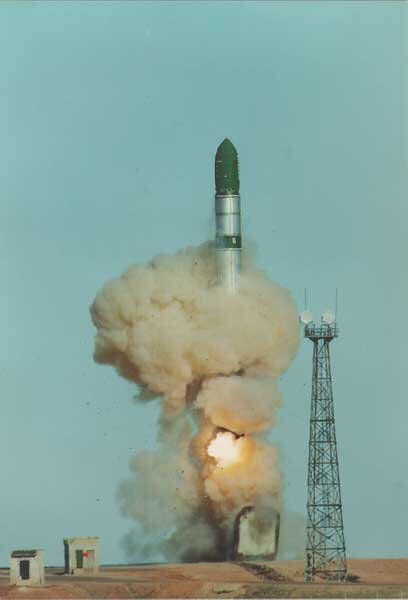
Development of the P-36M and MR-UR-100 started in the Yuzhnoye Design Bureau under the leadership of Mikhail Yangel, who proposed using the mortar launch “tested” on the RT-20P rocket. The concept of a heavy cold (mortar) launch was launched by Mikhail Yangel in the 1969 year. Mortar start allowed to improve the energy capabilities of the missiles without increasing the starting mass. The chief designer of TsKB-34, Yevgeny Rudyak, did not agree with this concept, considering the development of a mortar launch system for a rocket weighing more than two hundred tons impossible. After Rudyak’s departure in December 1970, the design office of special engineering (former KB-1 of the Leningrad TsKB-34) was headed by Vladimir Stepanov, who reacted positively to the idea of a cold launch of heavy missiles using a powder pressure accumulator.
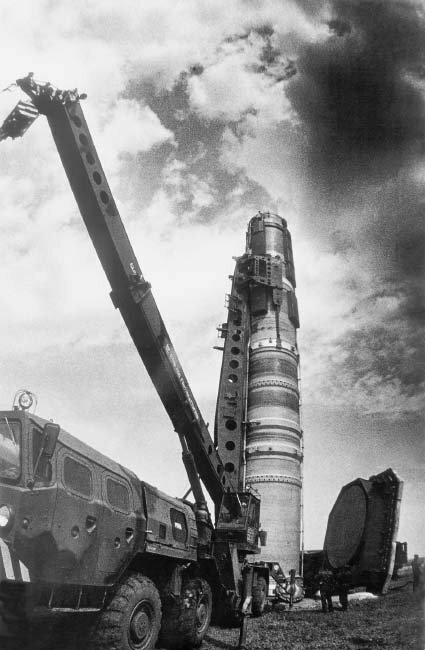
The main problem was the depreciation of the rocket in the mine. Previously, huge metal springs served as shock absorbers, but the weight of the P-36M did not allow them to be used. It was decided to use compressed gas as shock absorbers. The gas could hold more weight, but the problem arose: how to keep the high-pressure gas itself throughout the entire service life of the rocket? The KB Spetsmash team managed to solve this problem and refine the P-36 mines for new, heavier missiles. The production of unique shock absorbers started Volgograd plant "Barricades".
In parallel with the KBSM Stepanov, the Moscow KBTM under the direction of Vsevolod Solovyov worked on the development of the silo for the rocket. To absorb the rocket, located in the transport and launch container, KBTM was proposed a fundamentally new compact pendulum rocket suspension system in the mine. The sketch project was developed in 1970 year, in May of the same year, the project was successfully defended at the Ministry of General Education.
The final version adopted the modified mine launcher Vladimir Stepanov.
In December, the 1969 of the year developed the R-36M rocket project with four types of combat equipment - a monoblock light warhead, a monoblock heavy warhead, split warhead and a maneuvering warhead.
In March, 1970, the project of the rocket was developed with a simultaneous increase in silo protection.
In August, the 1970 Soviet Defense Council approved the proposal of the Yuzhnoye Design Bureau to upgrade the P-36 and create the P-36M missile system with advanced silo silo.
At the factory, the missiles were placed in a transport-launch container, where all the equipment needed for launching was placed, after which all necessary checks were carried out at the factory test bench. When replacing the outgoing P-36 with the new P-36M, a metal power cup with a depreciation system and PU equipment was inserted into the mine, and the whole enlarged assembly at the test site was simplified to only three (because the launcher consisted of three parts) with additional welds at zero starting point. At the same time, the exhaust channels and grids, which turned out to be unnecessary with the mortar start, were thrown out of the design of the launcher. As a result, mine security has increased markedly. The effectiveness of the selected technical solutions was confirmed by tests at the nuclear testing site in Semipalatinsk.
The R-36M rocket is equipped with a first-stage mid-flight engine, developed in KB Energomash under the guidance of Valentina Glushko.
"The designers assembled the first stage of the R-36M rocket consisting of six single-chamber engines, and the second stage was made of one single-chamber engine, maximally unified with the first stage engine - the differences were only in the high-altitude chamber nozzle. Everything was as before, but ... But engine development for the P-36M. Yangel decided to draw on KBKhA Konopatov ... New design solutions, modern technologies, an improved method for finishing the LRE, modernized stands and updated technological equipment - all this could put the gomash on the scales, suggesting its participation in the development of the P-36М and Mr-UR-100 complexes ... Glushko proposed for the first stage of the R-36М rocket four single-chamber engines operating according to the scheme with afterburning of the oxidizing generator gas, each using 100 ton pressure in the combustion chamber 200 atm, specific impulse at the ground 293 kg.s./kg, thrust vector control by deflecting the engine. According to the classification of KB Energomash, the engine received the designation RD-264 (four engines RD-263 on a common frame ... Glushko’s proposals were accepted, KBKhA The task was to develop a second stage engine for the P-36M. " The sketch design of the RD-264 engine was made in 1969 year.
The design features of the RD-264 engine include the development of supercharging units of oxidizer and fuel tanks, consisting of oxidizing or reducing low-temperature gas generators, flow correctors and shut-off valves. In addition, this engine had the ability to deviate from the axis of the rocket 7 degrees to control the thrust vector.
The challenge was to ensure reliable launch of the first-stage engines with a mortar launch. Engine fire tests on the bench began in April 1970 of the year. In 1971, the design documentation was transferred to the Southern Machine-Building Plant for the preparation of mass production. Engine tests were conducted from December 1972 of the year to January of the 1973 year.
During the flight tests of the R-36M rocket, the need to force the first stage engine by 5 percent was revealed. Bench testing of the forced engine was completed in September 1973 of the year, and the flight tests of the rocket continued.
From April to November 1977, the engine was modified at the stand of Yuzhmash to eliminate the causes of the revealed high-frequency oscillations at start-up. In December 1977, the Ministry of Defense issued a decision on engine refinement.
The second stage propulsion engine P-36M was developed in the chemical automation design bureau under the guidance of Alexander Konopatov. The development of the LRE RD-0228 Konopatov began in the year 1967. Development was completed in the 1974 year.
After the death of Yangel in 1971, Vladimir Utkin was appointed chief designer of the Yuzhnoye design bureau.
The control system of the MBR P-36М was developed under the leadership of the chief designer of the Kharkov Scientific Research Institute-692 (NPO Khartron) Vladimir Sergeev. The complex of means for overcoming the missile defense system was developed in the Central Scientific Research Institute. Solid propellant charges of powder pressure accumulators were developed at Soyuz LNPO under the direction of Boris Zhukov. A unified command post of increased mine-type security was developed at the TsKB TM under the direction of Nikolay Krivoshein and Boris Aksyutin. Initially, the warranty period was set for the storage of the 10 rocket for years, then for the 15 year.
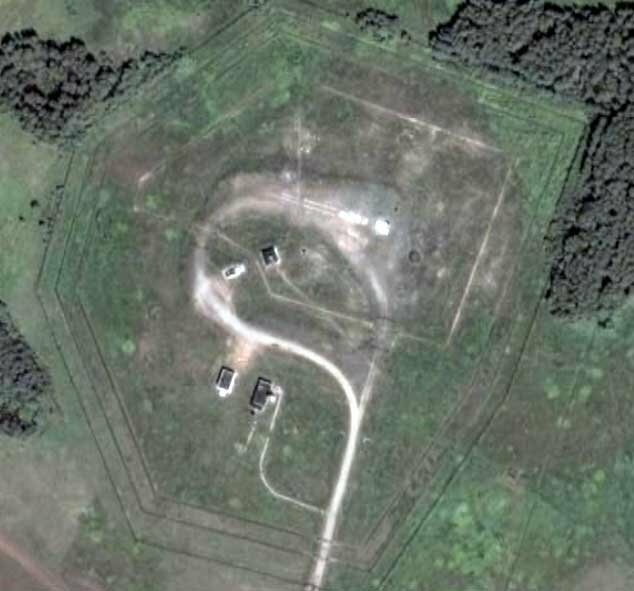
A great achievement of the new complexes was the possibility of remote retargeting before launching the rocket. For such a strategic weapons this innovation made a huge difference.
In 1970-1971 in KBTM, projects of two ground launch complexes were developed to provide throwing tests at the site 67 of the Baikonur test site. For these purposes, the main equipment of the launch complex 8P867 was used. The assembly and test case is built on the site number 42. In January, 1971, the missile tests began to test the mortar launch.
The essence of the second stage of the throwing tests was to work out the technology of a mortar launch of a rocket from a container using a powder pressure accumulator, which threw a rocket fueled with an alkaline solution (instead of real components) to a height of more than 20 m from the upper edge of the container. At the same time, three powder rocket engines, located on the pallet, took him aside, since the pallet protected the propulsion system of the first stage from the pressure of the PAD gases. Further, the rocket, having lost speed, fell near the container into a concrete tray, turning into a pile of metal. In total, 9 rocket launches were conducted to investigate the mortar launch.
The first launch of the P-36М flight test design program in 1972 at the Baikonur test site was unsuccessful. After leaving the mine, she rose into the air and suddenly fell right on the launch pad, destroying the launcher. Emergency were the second and third starts. The first successful test launch of a P-36M equipped with a single-block warhead was conducted on February 21 of the year 1973.
In September, the X-NUMX of the year went on to test a version of the P-1973M, equipped with an RCMIN with ten warheads (data on the version of a missile equipped with an RCMIN with eight warheads are given in the press)
The Americans closely watched the tests of our first ICBMs equipped with an RCMR.
The US Navy ship Arnold was located off the coast of the Kamchatka test site during launches. A four-engined aircraft-laboratory B-52, equipped with telemetry and other equipment, constantly patrolled the same area. As soon as the plane flew away to refuel, a launch vehicle was launched at the test site. If the launch during such a “window” could not be accomplished, then we waited until the next “window” or used technical measures to close the information leakage channels. ” Close these channels completely was impossible. For example, before launching missiles, Kamchatka warned by radio of its civilian pilots about the inadmissibility of flights during a certain period of time. Carrying out radio interception, US intelligence agencies analyzed the meteorological situation in the area and came to the conclusion that the upcoming missile launches could be the only obstacle to the flight.
In October, 1973 was commissioned by a government decree to develop a homing Mayak-1 (15F678) warhead with a gas-cylinder remote control for the R-36M rocket. In April, 1975, a draft design of a self-guided warhead was developed. Flight tests began in July 1978. In August, 1980, the tests of the self-guiding 15F678 warhead with two versions of the R-36М rocket sighting equipment were completed. These missiles were not deployed.
In October, 1974 of the year issued a government decree on reducing the types of combat equipment of the P-36М and Mr-UR-100 complexes. In October, the 1975 of the year completed the flight tests of the P-36M in three types of combat equipment and the RCM 15F143.
Development of the warheads continued. 20 November 1978 of the year by a government decree adopted a monoblock MS 15B86 as part of the complex Р-36М. November 29 The 1979 of the year was adopted by the 15F143Y РГЧ complex Р-36М.
In 1974, the Southern Machine-Building Plant in Dnepropetrovsk began mass production of the P-36M, head units and first-stage engines. Serial production of 15F144 and 15F147 warheads was mastered at the Perm Chemical Equipment Plant (PZHO).
December 25 A rocket regiment near the town of Dombarovsky of the Orenburg region took up combat duty.
The P-36M missile system was adopted by a government decree of December 30 of 1975. The same resolution was adopted by the ICBM MR-UR-100 and UR-100Н. For all the ICBMs, a unified automated combat control system (ASBU) of the Leningrad NPO Impuls was created and first used. This is how the missile was put on combat duty.
“According to the project, a plant-start scheme was provided, i.e., the rocket was transported directly from the factory to the silo launcher. This procedure was used for the first time, and the high reliability of the rocket systems was confirmed. At that, the time was reduced the rocket is in an unprotected state: only en route. Thus, during the LCI, the technology for preparing the rocket for launch was as follows:
1. From the railway platform, the container was loaded onto a transport trolley (crane loading was applied: the container was tugged from platform to trolley). Then the container was transported to the starting position, where it was similarly transferred to the installer, who loaded the container into the silo onto the vertical and horizontal shock absorbers. This made it possible to move it horizontally and vertically, which increased its security (more precisely, the security of the rocket - author's note) in a nuclear explosion.
2. Conducted electrical tests, aiming and entry flight tasks.
3. The rocket was refueled — one of laborious and dangerous operations. 180 and aggressive components were poured from the mobile filling tanks into the missile tanks, so they had to work in the means of protection.
4. Docked the head part (MFR or monoblock). Then proceeded to the final operations. The swivel roof was closed, everything was checked, the hatches were sealed up, and the silo was handed over to the guard of the guard. From now on, unauthorized access to silos is excluded. The rocket is put on combat duty, and from this second it can be controlled only by the combat crew of the command post. ".
It should be noted that the combat crew (duty shift) does not "control the rocket", but executes the orders of the higher levels of command and monitors the status of all the missile systems.
The combat missile systems with the R-36М ICBMs were deployed in the missile divisions that had previously been armed with the Р-36 missiles, and were in service until the 1983 year.
From 1980 to 1983, the P-36M missiles were replaced with the P-36M UTHC missiles.
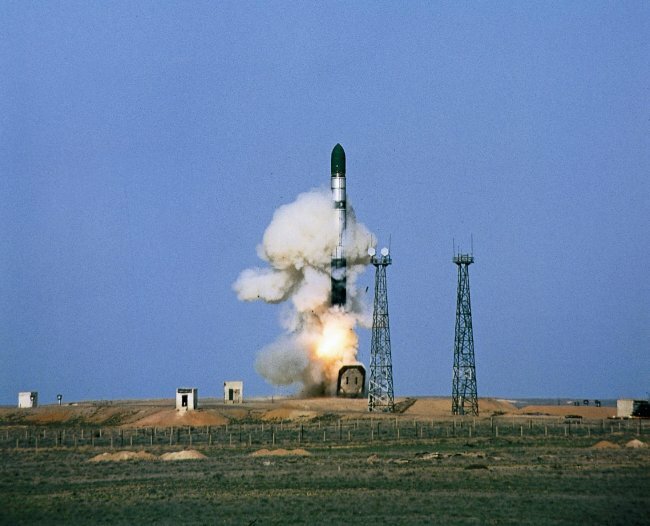
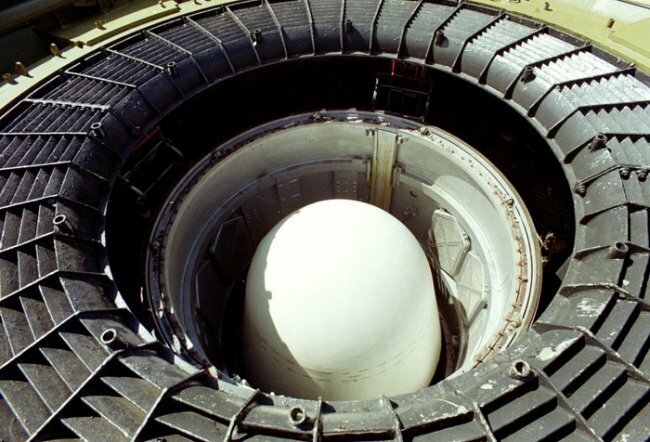
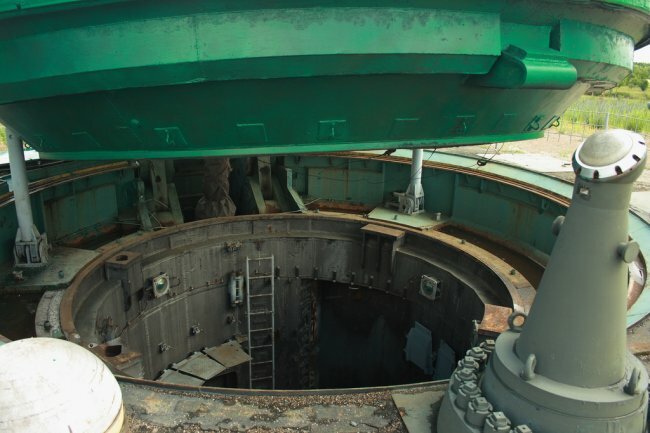
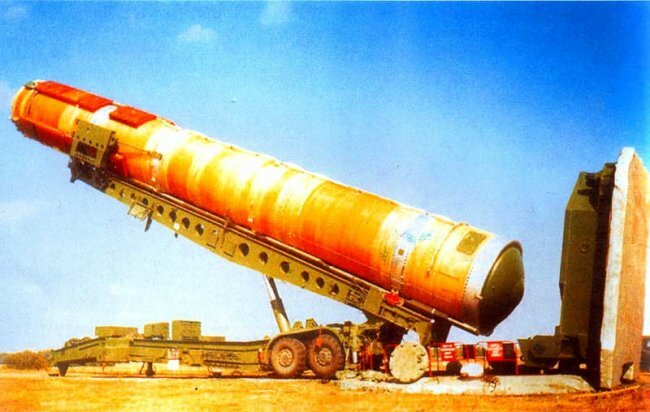
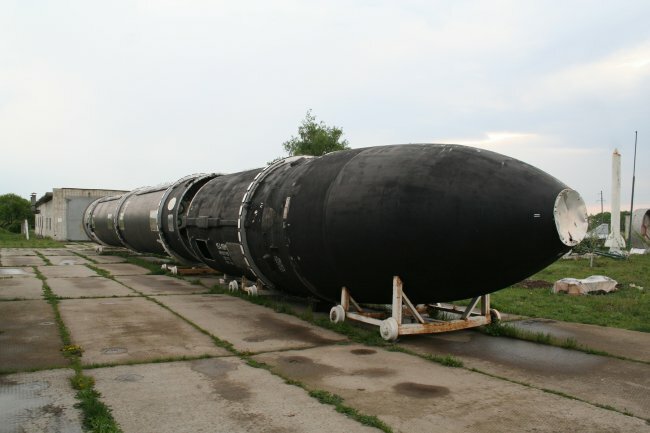
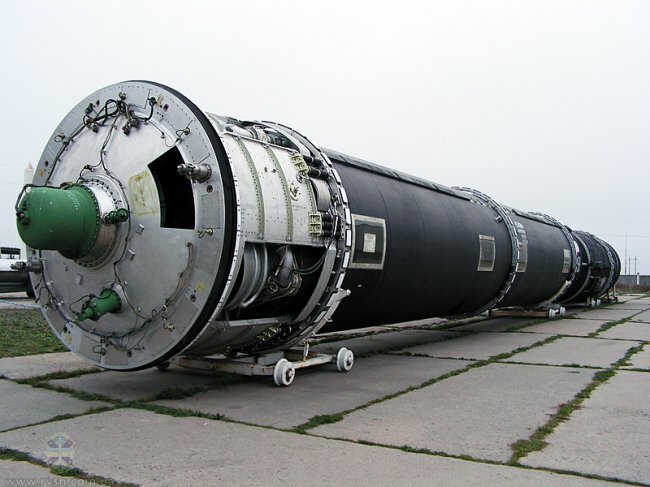
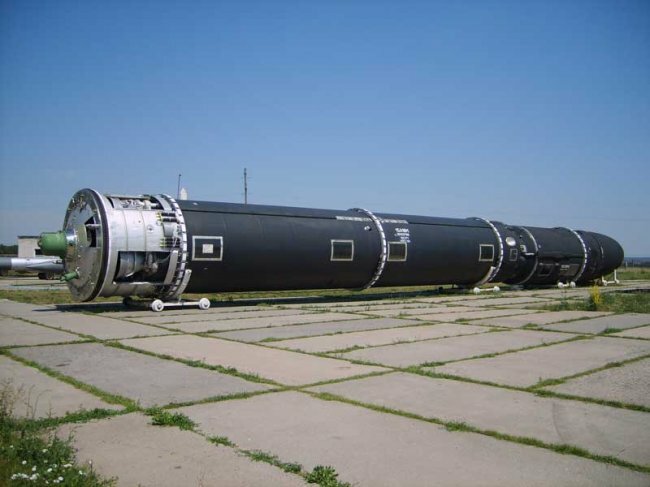
Information